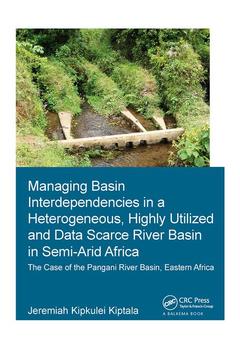Managing Basin Interdependencies in a Heterogeneous, Highly Utilized and Data Scarce River Basin in Semi-Arid Africa The Case of the Pangani River Basin, Eastern Africa IHE Delft PhD Thesis Series
Auteur : Kiptala Jeremiah Kipkulei

For integrated water resources management both blue and green water resources in a river basin and their spatial and temporal distribution have to be considered. This is because green and blue water uses are interdependent. In sub-Saharan Africa, the upper landscapes are often dominated by rainfed and supplementary irrigated agriculture that rely on green water resources. Downstream, most blue water uses are confined to the river channels, mainly for hydropower and the environment.
Over time and due to population growth and increased demands for food and energy, water use of both green and blue water has increased. This book provides a quantitative assessment of green-blue water use and their interactions. The book makes a novel contribution by developing a hydrological model that can quantify not only green but also blue water use by many smallholder farmers scattered throughout the landscape.
The book provides an innovative framework for mapping ecological productivity where gross returns from water consumed in agricultural and natural vegetation are quantified. The book provides a multi-objective optimization analysis involving green and blue water users, including the environment. The book also assesses the uncertainty levels of using remote sensing data in water resource management at river basin scale.
1 Introduction
2 Study Area
3 Land Use and Land Cover Classification
4 Mapping Evapotranspiration using MODIS and SEBAL
5 Modelling Stream Flow using STREAM Model
6 Water Productivity
7 Multi-Objective Analysis of Green-Blue Water
8 Conclusions
Jeremiah Kipkulei Kiptala is a lecturer of water resources engineering at the Department of Civil, Construction and Environmental Engineering, Jomo Kenyatta University of Agriculture and Technology, Kenya. He has a bachelor degree in Civil Engineering from the University of Nairobi, Kenya and a Master of Science in Water Management from UNESCO-IHE, the Netherlands. He is a professional civil engineer with the Engineers Board of Kenya and a corporate member of the Institute of Engineers of Kenya. For his PhD, Jeremiah conducted research on managing basin interdependencies in the Pangani River basin, Eastern Africa. His research interests include hydrological and river system modeling, multi-objective optimization, water valuation and ecosystem services valuation.
Date de parution : 09-2018
17.4x24.6 cm
Disponible chez l'éditeur (délai d'approvisionnement : 14 jours).
Prix indicatif 184,47 €
Ajouter au panierDate de parution : 11-2016
17.4x24.6 cm
Disponible chez l'éditeur (délai d'approvisionnement : 14 jours).
Prix indicatif 93,24 €
Ajouter au panierThèmes de Managing Basin Interdependencies in a Heterogeneous... :
Mots-clés :
Pangani River Basin; land use and land cover; Multi-temporal Moderate Resolution Imaging Spectroradiometer; evapotranspiration; NDVI Curve; remote sensing; Pangani Basin; resevoir operation; Blue Water Flows; MODIS; Rainfed Maize; water allocation; LULC Type; rainfed agriculture; Natural Land Cover; supplementary irrigation; Irrigated Sugarcane; surface energy balance algorithm; Ground Truthing Data; integrated water resources management; Blue Water; green-blue water multi-objective analysis; Open Water Evaporation; Africa's data scarce river basins; Green Water; Actual Et; Economic Water Productivity; Evaporation Depletion; LULC Classification; Moisture Content; RS Data; MODIS Data; Crop Calendar; Nash Sutcliffe Efficiency; Hydropower Production; Dominant Hydrological Processes; NDVI Value



